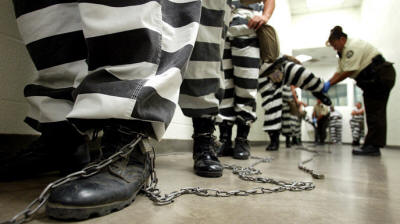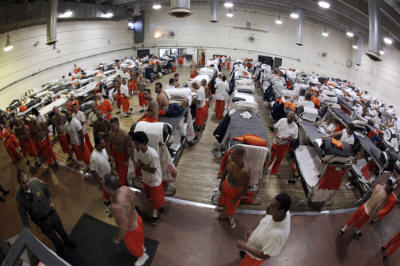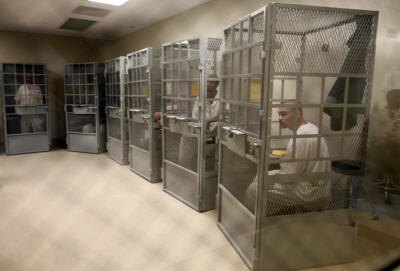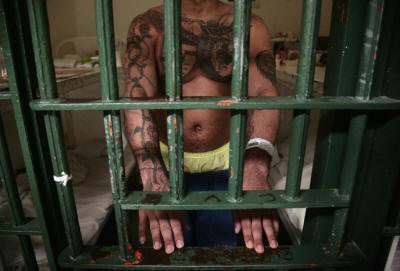|
from RT Website
for chain gang duty in Phoenix, Arizona October 21, 2003.
(Reuters/Shannon Stapleton)
One only cringes to imagine the detrimental psychological effects that kind of solitude creates for individuals who are subjected to solitary confinement for years at a time, knowing only the walls of their cell and the shades of light that creep across them.
The abhorrent state of affairs at the Guantanamo facility often makes international headlines and arguably overshadows the calamity that is the US domestic prison system - where over six million people are subject to some form of correctional supervision, an amount exceeding those who toiled in the Soviet gulags during Stalin’s reign. In the United States, some fifty thousand inmates pass their days in solitary confinement.
While there is undoubtedly no shortage of
violent criminals in America’s jails, millions are dolled out annually by
privately owned prison lobbies directly to politicians in an effort to
influence harsher ‘zero tolerance’ legislation and mandatory sentencing for
many non-violent offenses.
Like any other business, these institutions are run for the purpose of turning a profit. State and federal prisons are contracted out to private companies who are paid a fixed amount to house each inmate per day.
Their profit depends on spending the minimum amount necessary on each inmate day-to-day, allowing private-hands to pocket the remaining money.
For the corrections conglomerates of America, success depends on housing the maximum numbers of inmates for the longest potential time as inexpensively as possible. Consider that the United States has the highest incarceration rate in the world, far surpassing any other nation – for every 100,000 Americans, 743 citizens sit behind bars.
The harsher sentences meted out to non-violent
offenders in contrast to other industrialized nations speaks volumes of
America’s enthusiastic embrace of a prison industrial complex. Inmates walk around a gymnasium where they are housed due to overcrowding at the California Institution for Men state prison in Chino, California, June 3, 2011.
(Reuters/Lucy Nicholson)
The argument is that by subjecting correctional services to market pressures, efficiencies will be increased and prison facilities can be run at a lower cost due to market competition.
What these privatizations produce in turn is a system that destroys families by incentivizing the mass long-term detention of non-violent criminals, a system that is increasingly difficult to deconstruct and reform due to millions paid out to state and federal policymakers.
According to reports issued by advocacy group Public Campaign, the three major corrections firms,
...have spent over $22 million lobbying Congress
since 2001.
Senators like Lindsay Graham and John McCain have received significant sums from the private prison corporations while Chuck Schumer, Chair of the Rules Committee on Immigration and Border Enforcement, received at least $64,000 from lobbyists.
The prison lobby thrives off of laws that criminalize migrants and submit them to mandatory detention prior to being deported, sometimes up to 10 months or more; private firms have consistently pushed for the classification of immigration violations as felonies to justify throwing more and more immigrants behind bars.
The number of illegal immigrants being
incarcerated inside the United States has risen exponentially under
Immigration and Customs Enforcement, an agency responsible for annually
overseeing the imprisonment of 400,000 foreign nationals at the cost of over
$1.9 billion on custody-related operations.
Arizona's SB 1070 requires police to determine the immigration status of someone arrested or detained when there is “reasonable suspicion” that they’ve illegally entered the US, which many view as an invitation for rampant racial profiling against non-whites.
While the administration of Arizona’s Governor Jan Brewer is lined with former private prison lobbyists, its Department of Corrections budget has been raised by $10 million in 2012, while all other Arizona state agencies were subject to budget cuts during that fiscal year.
The concept of privatizing prisons to reduce expenses comes at great cost to the inmates detained, who are subjected to living in increasingly squalid conditions in jail cells across America.
In 2007, the Texas Youth Commission (TYC),
a state agency that overseas juvenile corrections facilities, was sent to a
West Texas juvenile prison run by GEO Group for the purpose of monitoring
its quality standards.
at San Quentin state prison in San Quentin, California, June 8, 2012.
(Reuters/Lucy Nicholson)
Independent auditors later visited the facility and discovered that inmates were forced to urinate or defecate in small containers due to a lack of toilets in some of the cells.
The independent commission also noted in their list of reported findings that the facility racially segregated prisoners and denied inmates access to lawyers and medical treatment. The ACLU and Southern Poverty Law Center have also highlighted several cases where GEO Group facility administrators turned a blind eye to brutal cases of rape and torture within their facilities, in addition to cases of its staff engaging in violence against inmates.
According to the Justice Department data, nearly
210,000 prisoners are abused annually (prison personnel are found
responsible half the time), while 4.5 percent of all inmates reported sexual
assaults and rape.
Under Obama’s watch, today’s private prison population is over 17 times larger than the figure two decades earlier.
Accordingly, Obama’s drug czar, Gil Kerlikowske, has condemned the recently passed state laws in Colorado and Washington that legalize the possession of marijuana in small amounts. The Obama administration is bent on keeping in place the current federal legislation, where a first-time offender caught with marijuana can be thrown in prison for a year.
It’s easy to see why common-sense decriminalization is stifled - an annual report released by the CCA in 2010 reiterates the importance of keeping in place harsh sentencing standards,
in Los Angeles, California October 3, 2012.
(Reuters/Jason Redmond)
Today, African-Americans make up 40% of the prison population and are incarcerated seven times more often than whites, despite the fact that African-Americans make up only 12% of the population.
Inmates are barred from voting in elections after their release and are denied educational and job opportunities.
The disproportionate levels of black people in
prisons is undeniably linked to law enforcement’s targeting of intercity
black communities through anti-drug stipulations that command maximum
sentencing for possession of minute amounts of rock cocaine, a substance
that floods poor black neighborhoods.
Mumia Abu-Jamal, America’s most famous political prisoner, has spent over three decades on death row; he was convicted in 1981 for the murder of a white police officer, while forensic experts say critical evidence vindicating Jamal was withheld from the trial.
In an interview with RT, Jamal relates his youth activism with the Black Panthers party against political imprisonment in contrast to the present day situation,
The fear and immortality the system perpetuates shows no sign of abating.
Being one of the few growth industries the
United States has left, one can only imagine how many people will be living
in cages in the decades to come. |




